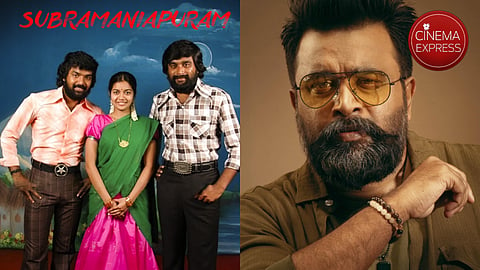

Seventeen years after Subramaniapuram hit screens and redefined independent filmmaking in Tamil cinema, its creator M Sasikumar remains deeply attached to the film’s making, moments, and memories. In a recent conversation with Cinema Express, following the release of his latest film, Tourist Family, the actor-director revisited the origin story of his cult debut and the ideas that shaped it.
“The first scene I ever wrote for Subramaniapuram was the climax,” Sasikumar revealed. “A woman being used as bait to murder her lover—it was a haunting image I couldn't get out of my head. I was fixated on that moment and wrote the rest of the story by working backwards, building an entire narrative leading to it.”
The film’s controversial ending, where the character Thulasi (played by Swathi) indirectly contributes to the death of her lover Azhagar (Jai), stirred intense reactions, especially from audiences in Madurai. “People hurled abuses at Swathi’s character,” Sasikumar said. “They were furious with Kanagu’s character too, played by Samuthirakani. In fact, I asked Kani Anna not to visit theatres during the release, fearing for his safety. But he told me, ‘If the audience is angry at my character, that’s the biggest award I can receive.’ Still, I felt bad for having written such a negative character for a friend like him.”
Wanting to change that public perception, Sasikumar later cast Samuthirakani in a positive role in his second directorial, Easan. “I made sure his character was an embodiment of goodness. I even named him Sangaiah—after God.”
Sasikumar also shared a lesser-known anecdote about the film's certification process. “I initially asked for an ‘A’ certificate, thinking the film wouldn’t resonate with women. But two women from the CBFC changed my view entirely. They said women would connect with the film’s emotions and message. Thanks to their insight, I agreed to a ‘U/A’ certificate, and that decision helped Subramaniapuram reach a wider, family audience.”
Recalling moments from the shoot, Sasikumar fondly remembered how each day on set began with the now-iconic track 'Kangal Irandal'. “Swathi’s character was always walking beside Jai’s character during the romantic sequences. One day, she jokingly said, ‘You’re just going to make me walk down yet another street while you play 'Kangal Irandal,' right?’ To tease her, I told her that the next day she’d have to run from a dog—and since we didn’t have a trained dog, I’d chase her myself.”
That chase sequence eventually made it into the trailer, sparking curiosity among audiences. “I was worried I had wasted a day shooting that scene, so I put it in the trailer just to tease viewers. Many thought it was an alternate climax where Paraman (played by me) kills Thulasi. But no, there’s no alternate ending. We ensured that footage was used to make the audience sit till the very end of the film.”
Released on July 4, 2008, Subramaniapuram not only catapulted Sasikumar and his cast to fame but also opened the doors for raw, rooted, small-town storytelling in Tamil cinema. The film's ensemble cast comprised Sasikumar, Jai, Swathi, Samuthirakani, Ganja Karuppu, Namo Narayana, Maari, and Vichithran. The film also marked Swathi's Tamil film debut. The music was composed by James Vasanthan, with cinematography by S. R. Kathir and editing by Raja Mohammad.
Despite its modest budget, the film garnered widespread critical acclaim for its innovative storytelling, direction, screenplay, editing, and music. Its meticulous attention to detail in sets and costumes brought 1980s Madurai to life. Remarkably, the film was shot in just 85 days and went on to become one of the year's biggest commercial hits. Seventeen years on, its influence continues to be felt, and its legacy remains intact.